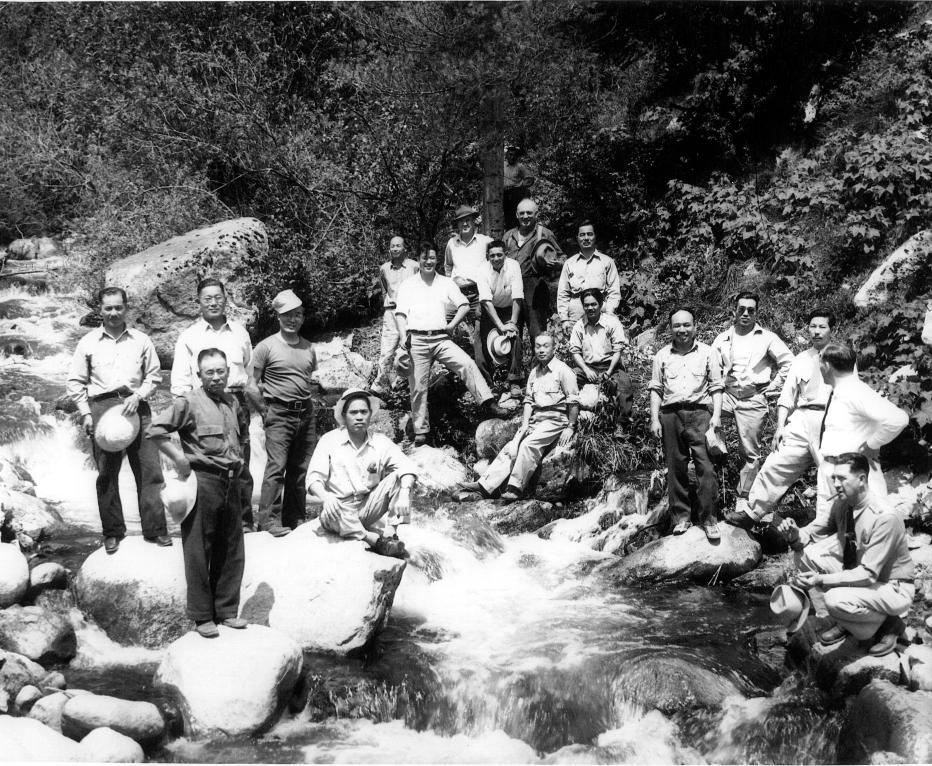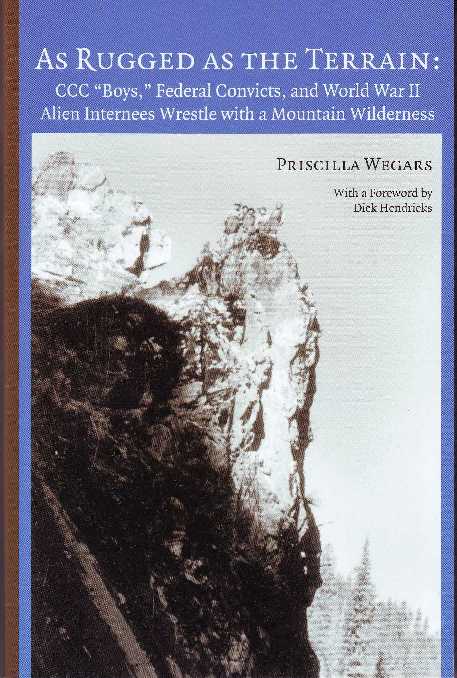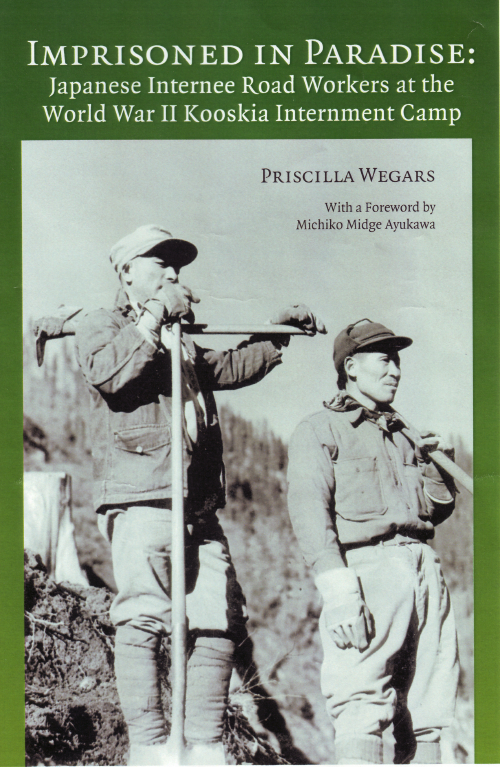

| Asian American Comparative Collection (AACC) University of Idaho 875 Perimeter Drive, MS 1111 Moscow, Idaho 83844-1111 USA 208-885-7075 |
Priscilla Wegars, Ph.D., Volunteer Curator pwegars@uidaho.edu Renae Campbell, M.A., RPA, Research Assistant rjcampbell@uidaho.edu |


Scheduled PowerPoint presentation and book signing:
Please email pwegars@moscow.com to schedule a PowerPoint presentation and/or a book signing.
AS RUGGED AS THE TERRAIN: CCC "BOYS," FEDERAL
CONVICTS, AND
ALIEN INTERNEES WRESTLE WITH A MOUNTAIN WILDERNESS
by Priscilla Wegars with a Foreword by Dick Hendricks
Caxton Press, in cooperation with the University of Idaho's
Asian
American Comparative Collection (AACC), has published As
Rugged as the
Terrain: CCC "Boys," Federal Convicts, and
World War II Alien Internees
Wrestle with a Mountain Wilderness;
all author's royalties benefit the
AACC. Rugged, by Priscilla Wegars; is the
"prequel" to her Imprisoned
in Paradise: Japanese Internee Road Workers at
the World War II Kooskia
Internment Camp (2010).
This Idaho site, where turbulent Canyon Creek meets the wild
and scenic
Lochsa River, has an intriguing history spanning well over 100
years.
First a likely Nez Perce campsite, in 1893 it was a footnote
in the saga
of the ill-fated Carlin hunting party. Forty years later, in
1933, it
held nearly 200 tent-dwelling Civilian Conservation Corps
recruits, most
from New York State. The antics of these "city slickers"
provide
colorful insights into both CCC camp operations and the lives
of young
men far from home.
In the summer of 1935 the site housed Federal Prison Camp No.
11, a
road-building facility for convicts from the Leavenworth,
Kansas,
penitentiary, and later from other institutions. Foreword
author Dick
Hendricks, the prison camp's chief clerk from 1937 to 1939
and now 104 years old, described how the authorities
stressed rehabilitation, rather than punishment.
Upon the prison camp's closure in May 1943, the site
immediately became
the Kooskia Internment Camp for Japanese non-citizen men
(closed in May
1945). While their story has already been told in "Imprisoned
in
Paradise," several chapters in "Rugged" present additional
information
about the internment camp, including the medical and dental
care offered
there.
Another chapter discusses the area's WWII camps for Italian
and German
internees (not POWs). The Italian internees could freely visit
local
towns near their camps, and thus were more privileged than the
Japanese
internees. German internees worked on road access construction
in the
Nez Perce National Forest, and sometimes helped fight forest
fires.
As Rugged as the Terrain has over 400 pages with
110 illustrations,
including maps; has appendices, notes, a bibliography, and an
index; and is $21.95.
For an autographed copy, send your check for $25 payable to
"AACC" to the
author at the address at the top of this page. Price includes
tax and postage
(media mail).
Title: As Rugged as the Terrain:
CCC "Boys," Federal Convicts, and World War II Alien
Internees
Wrestle with a Mountain Wilderness
Author: Priscilla Wegars
Price: $21.95
Publisher: Caxton/AACC
Format: 6 x 9
Number of pages: 393 + xxxviii [431]
ISBN: 978-0-87004-540-0
Publication date: April 2013
Illustrations: 110 b&w photographs & documents, 3
maps
Back matter: Appendices, notes, bibliography, index
Foreword by: Dick Hendricks
Distributor: University of Nebraska Press through Longleaf
Services, Inc., 116 S. Boundary St., Chapel Hill, NC
27514-3808, Phone: 800-848-6224, Fax: 800-272-6817.
Additional: All author's royalties benefit the University of
Idaho's Asian American Comparative Collection (AACC),
<http://www.uiweb.uidaho.edu/aacc/>.
Author information: Priscilla Wegars is the volunteer curator
of the University of Idaho's Asian American Comparative
Collection (AACC), a resource center of artifacts, images, and
bibliographical materials that help a wide range of
individuals better understand the history, culture, and
archaeology of Asian Americans in the West. She has a Ph.D. in
history from the University of Idaho, Moscow, and is also an
independent editor, historian, historical archaeologist, and
artifact analyst. Her earlier research focused on Chinese
immigrants in the West, and her book, Polly Bemis: A
Chinese American Pioneer (Cambridge, ID:
Backeddy Books, 2003), received Honorable Mention from the
Idaho Library Association as the Idaho Book of the Year for
2003. She is also the editor of Hidden Heritage:
Historical Archaeology of the Overseas Chinese
(Amityville, NY: Baywood, 1993) and is co-editor, with Sue
Fawn Chung, of Chinese American Death Rituals:
Respecting the Ancestors (Lanham, MD: AltaMira,
2005). Her next project will be a full-length biography of
Polly Bemis.
A preview of As Rugged as the Terrain is also
available to audiences as a PowerPoint presentation. For more
information, please contact Priscilla Wegars,
pwegars@moscow.com.
For illustrations, please contact Priscilla Wegars,
pwegars@uidaho.edu.
A limited number of review copies of As Rugged as the
Terrain are available. To obtain a copy for
review, please contact Priscilla Wegars, pwegars@uidaho.edu.
Read a review
of it by John Streamas on amazon.com.
Read a review
of it by Inez Hopkins in The Idaho Librarian, May
2014.
Read a review
of it by Heather Fryer in the Pacific Historical Review,
May 2015.
Photo courtesy Homer Yasui
 Scheduled
PowerPoint Presentation with Book Signing:
Scheduled
PowerPoint Presentation with Book Signing:
Please email
pwegars@moscow.com to schedule a PowerPoint presentation
and/or a book signing.
******************************************************************************************
The long-awaited account of Idaho's World War II Kooskia
Internment Camp is now available. Titled Imprisoned in
Paradise: Japanese Internee Road Workers at the World War II
Kooskia Internment Camp, it describes a unique,
virtually forgotten, World War II detention and road building
facility that was located on the remote, wild, and scenic
Lochsa River in north central Idaho at the site of an earlier
CCC camp and a former federal prison camp above Lowell, Idaho.
Between mid-1943 and mid-1945 the Kooskia (KOOS-key) camp held
an all-male contingent of some 265 so-called "enemy aliens" of
Japanese ancestry. Most came from 21 states and 2 territories,
but others were from Mexico; some were even kidnapped from
Panama and Peru. Two alien internee doctors, an Italian and
later a German, provided medical services; 25 Euroamerican
employees included several women; and a Japanese American man
censored the mail.
Despite having committed no crimes, but suspected of potential
sabotage, these noncitizen U.S. residents of Japanese descent
had been interned elsewhere in the U.S. following Japan's
attack on Pearl Harbor in December 1941. They volunteered for
transfer to the Kooskia Internment Camp and earned wages for
helping build the Lewis-Clark Highway, now Highway 12, between
Lewiston, Idaho, and Missoula, Montana, supervised by U.S.
Bureau of Public Roads employees. [Highway 12, of course, has
lately been very much in the news because of the controversial
proposal to use this wilderness route, the Northwest Passage
Scenic Byway, for transporting 200 oversize (210 feet long, 30
feet tall, 24 feet wide) loads of heavy equipment (300 tons
per shipment) from Lewiston to the oil extractive tar sands in
Alberta, Canada.]
Whereas some of the all-male internees held camp jobs, most of
these paid volunteers were construction workers, operating
heavy equipment or laboring with picks and shovels. The
internees found this area of the Idaho wilderness to be a
welcome change from the barbed wire of the Santa Fe Detention
Center and other places where they were previously confined.
For example, Yoshito Kadotani, a landscape gardener from Santa
Cruz, California, called it "… a paradise in mountains!,"
saying, "It reminds me so much of Yosemite National Park."
Knowledge of their rights under the 1929 Geneva Convention
empowered the Kooskia internees to successfully challenge
administrative mistreatment, thereby regaining much of the
self-respect they had lost by being so unjustly interned.
Here, finally, is their story.
Title: Imprisoned
in Paradise: Japanese Internee Road Workers at the World
War II Kooskia Internment Camp
Author: Priscilla Wegars
Price: $19.95
Publisher: Asian American Comparative Collection (AACC),
University of Idaho, Moscow
Format: 6 x 9
Number of pages: 323 + xxxiv (357)
ISBN: 978-0-89301-550-3
Publication date: August 30, 2010
Illustrations: 110 b&w photographs, 2 maps
Back matter: Appendix, notes, bibliography, index
Foreword by: Michiko Midge Ayukawa
Distributor: University of Nebraska Press through Longleaf
Services, Inc., 116 S. Boundary St., Chapel Hill, NC
27514-3808, Phone: 800-848-6224, Fax: 800-272-6817.
Additional: All author's royalties benefit the University of
Idaho's Asian American Comparative Collection (AACC),
<http://www.uiweb.uidaho.edu/aacc/>. For an autographed copy, send
your check for $25 payable to "AACC" to the author at the
address at the top of this page. Price includes tax and
postage (media mail).
Author information: Priscilla Wegars is the volunteer curator
of the University of Idaho's Asian American Comparative
Collection (AACC), a resource center of artifacts, images, and
bibliographical materials that help a wide range of
individuals better understand the history, culture, and
archaeology of Asian Americans in the West. She has a Ph.D. in
history from the University of Idaho, Moscow, and is also an
independent editor, historian, historical archaeologist, and
artifact analyst. Her earlier research focused on Chinese
immigrants in the West, and her book, Polly Bemis: A
Chinese American Pioneer (Cambridge, ID:
Backeddy Books, 2003), received Honorable Mention from the
Idaho Library Association as the Idaho Book of the Year for
2003. She is also the editor of Hidden Heritage:
Historical Archaeology of the Overseas Chinese
(Amityville, NY: Baywood, 1993) and is co-editor, with Sue
Fawn Chung, of Chinese American Death Rituals:
Respecting the Ancestors (Lanham, MD: AltaMira,
2005). She is particularly interested in locating families of
Kooskia Internment Camp internees and employees.
A preview of Imprisoned in
Paradise is also available to audiences as a
PowerPoint presentation. For more information, please contact
Priscilla Wegars, pwegars@moscow.com.
Illustrations:
1. A photograph of the Kooskia Internment Camp buildings is at
http://www.uiweb.uidaho.edu/aacc/kcamp.tif.
Permission
to use is hereby granted. Credit and caption information:
Kooskia Internment Camp, north central Idaho, 1943-1945.
Photographer unknown. Photo courtesy of the Clearwater
National Forest, Lochsa District, Kooskia Ranger Station,
Kooskia, Idaho and the Asian American Comparative Collection,
University of Idaho, Moscow. Far left, water tower; center,
dormitories, wash room, and recreation hall; right, mess
hall/kitchen; administration building, containing offices for
superintendent and censor, and two bedrooms for guards;
laundry/warehouse; boiler room/powerhouse; generator/shop.
2. A photograph of some of the Kooskia internees is at http://www.uiweb.uidaho.edu/aacc/kmen.tif.
Permission to use is hereby granted. Credit and caption
information: Kooskia Internment Camp Anniversary Picnic, May
25, 1944. Photographer unknown. Photo courtesy of Mickey
Barton and the Asian American Comparative Collection,
University of Idaho, Moscow.
3. Other images are available at the University of Idaho
Library Special Collections at http://digital.lib.uidaho.edu/cdm/search/collection//searchterm/Kooskia
internment camp/. Please apply to them for permission to
reprint.
A limited number of review copies of Imprisoned in Paradise are available. To
obtain one for review, please contact Linsey Gonzales,
Publishing Assistant, Caxton Press, 312 Main Street, Caldwell,
Idaho, 83605-3299, on media letterhead.
Read a review of
it by Connie Y. Chiang in the Western Historical Quarterly, Winter 2011.
Read a review of it (2nd page) by Eric Walz
in Montana: The Magazine of
Western History, Summer 2011.
Read a review of
it by Arthur A. Hansen in the Pacific Northwest Quarterly, Spring 2011.
Read a review
of it by Kevin Taylor in the Inlander, March 2011.
Read a review
of it by Katie Schneider in the Oregonian, January 2011.
Read a review
of it by Wayne Maeda in Nichi
Bei Times, January 2011.
Read an interview
by Leonard Chan with Priscilla Wegars in the November/December
2010 issue of the AACP
[Asian American Curriculum Project] Newsletter.
Read a review
of it by Robert L. Sappington on amazon.com.
Read a review
of it (scroll down) in Densho
eNews, August 2010.
See also the Kooskia Internment
Camp Archaeological Project, directed by Dr. Stacey
Camp.
Immediately following Japan's attack on Pearl Harbor, numerous Japanese, German, and Italian aliens were arrested and detained on no specific grounds, without the due process guaranteed to them by the U.S. Constitution, and were sent to INS detention camps at Fort Missoula, Montana; Bismarck, North Dakota; and elsewhere. The INS camps were separate and distinct from the ten major camps under War Relocation Authority (WRA) supervision. The WRA camps, including Minidoka (now the Minidoka National Historic Site) near Jerome, in southern Idaho, housed some 120,000 American citizens and permanent resident aliens of Japanese ancestry who were unconstitutionally removed, relocated, and imprisoned by the U.S. government during World War II.
Although there were a number of
Justice Department internment camps throughout the United States
during WWII, the Kooskia Internment Camp was unique because it was
the only camp of its kind in the United States. Its inmates
had volunteered to go there from other camps, and received wages
for their work. A total of some 265 male Japanese aliens; 24
male and 3 female Euroamerican civilian employees; 2 male internee
doctors, one Italian and one German; and 1 male Japanese American
interpreter occupied the Kooskia Internment Camp at various times
between May 1943 and May 1945. Although some of the
internees held camp jobs, most of the men were construction
workers for a portion of the present Highway 12 between Lewiston,
Idaho, and Missoula, Montana, parallel to the wild and scenic
Lochsa River.
The Japanese internees at the
Kooskia camp came from Alaska, California, Colorado, Connecticut,
Florida, Hawai'i, Idaho, Illinois, Kentucky, Louisiana, Maryland,
Massachusetts, Minnesota, Montana, Nevada, New Jersey, New York,
Ohio, Oregon, Pennsylvania, Texas, Utah, and Washington. They
included Reverend Hozen Seki, founder of the New York
Buddhist Church; Toraichi Kono, former employee of Charlie
Chaplin; and Japanese Latin Americans kidnapped from their
respective countries, chiefly Peru, by U.S. government agencies.
"Digging in the documents" has produced INS, Forest Service,
Border Patrol, and University of Idaho photographs and other
records. These, combined with internee and employee oral and
written interviews, illuminate the internees' experiences,
emphasizing the perspectives of the men detained at the Kooskia
Internment Camp.
Click here
for a list of California towns of origin or residence for Kooskia
internees.
Click here
for information on how to obtain Department of Justice (DOJ)
Closed Legal Case Files (CLCF) from the National Archives and
Records Administration (NARA).
Click here for a table of Justice Department and U.S. Army Internment Camps and Detention Stations in the U.S. during World War II.
Click
here for tables related to food and clothing at the Kooskia
Internment Camp.
Click here
for tables related to bids for services, if needed, covering
hospitalization and death [no deaths occurred] at the Kooskia
Internment Camp.
For more information or to schedule
a talk, please contact:
Priscilla Wegars
Kooskia Internment Camp Project
735 East Sixth Street
Moscow, Idaho 83843
(208) 882-7905; pwegars@moscow.com